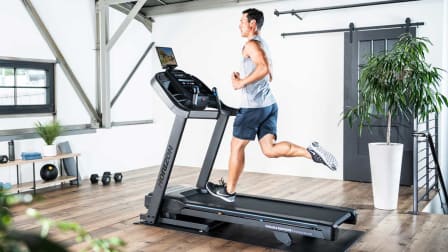Best Equipment for a Home Gym
Whatever your budget, you can get the exercise you need without a gym membership
When you shop through retailer links on our site, we may earn affiliate commissions. 100% of the fees we collect are used to support our nonprofit mission. Learn more.

If you have gym equipment at home, you eliminate one major hurdle of getting a workout in: finding time to get to the gym.
The coronavirus pandemic inspired many people to invest in home exercise gear—buying everything from adjustable dumbbells to high-end treadmills and exercise bikes. And those investments can also help you stay in shape as the weather turns colder and darker.
Whether you’re looking to expand your home gym or setting one up from scratch, whatever your budget, making it easy to get your exercise in is essential:
The U.S. Physical Activity Guidelines (PDF) recommend doing a minimum of 150 minutes of moderate-intensity aerobic exercise (half that amount if it’s vigorous) and at least two whole-body strength training sessions each week. That’s achievable at home, even with a very basic setup.
“There’s a misconception that you need all sorts of snazzy equipment at home, like what you see at the gym, but that’s just not the case,” says Michael Piercy, MS, an American Council on Exercise master trainer (he teaches other trainers) and owner of the Lab in Fairfield, N.J. “You can get a great workout with just a couple of pieces of equipment.”
Your Fitness Goals and Your Space
Before you start thinking about your budget, there are two key factors that will be different for everyone considering setting up a home gym: your fitness goals and the physical space you have available.
“Start at your fitness goals,” says Peter Anzalone, a former senior test project leader for fitness equipment at Consumer Reports. “You want whatever equipment you’re purchasing to be able to support those goals.”
If You Want to Spend $20 to $1,000
At a minimum: Invest in a yoga mat (from $20), which you can use for yoga, stretching, and floor exercises. See CR’s guide to yoga mats to find a mat that will best fit your needs.
Then, for strength training, add two sets of dumbbells ($30 and up, depending on the weights), one lighter and one heavier, McCall says. For a little more versatility, he also recommends adding a two-arm resistance band that you can attach to a door frame (from $20). “It acts like a cable machine at the gym,” says McCall. “You can do a lot of exercises from a standing position vs. seated, which engages muscles from your shoulders to your hips.”
Cardio machines are hard to afford with a limited budget, but you can find indoor stationary bikes for less than $500 and rowing machines for less than $800. Quality varies. While CR does not currently test rowing machines, CR has rated a selection of exercise bikes, with the most affordable widely available highly rated bike coming in at $800.
You could also consider a set of adjustable dumbbells ($220 and up), which can facilitate a full-body strength-training routine.
If you already have an outdoor bike, mounting it on a bike trainer ($100 and up) lets you easily convert it into an indoor cardio machine.
A jump rope (from $10) is another versatile option with a small price: It can provide an excellent cardio workout (and is good for circuit training), as long as you have outdoor space or high ceilings.
If you’re considering buying a used treadmill, see our tips for choosing one that is likelier to last. Quality treadmills for less than $1,000 can be hard to come by, but if that is all you want in your home gym, CR recommends several treadmills right around this price. The Horizon 7.0 AT, $1,000, is durable, well-constructed, and easy to use.
To see more treadmills from CR’s reviews of dozens of models from LifeSpan, Nautilus, NordicTrack, Precor, and others, check our treadmill ratings and our buying guide for more information.
If You Want to Spend $1,000 to $3,000
Keep the mat, weights, bands, and jump rope, and add a stability ball or a ball-bench hybrid (you can lift it, use it as a weight bench, or stand on it). McCall also recommends a suspension trainer (less than $200), such as the TRX, which anchors in a door frame and adds an extra stability challenge to body weight exercises.
For cardio, you have a few more options in this price range. With treadmills at this price, says Anzalone, expect a little more horsepower, a slightly thicker deck, a slightly larger running surface, and more connectivity (like Bluetooth) options than you’d get with the least expensive models.
You can get a fully featured folding treadmill (good for tight spaces) like the Sole F80 for about $1,700. It comes with a chest-strap heart rate monitor (key for tracking your intensity and progress over time) and a variety of exercise programs.
An elliptical can be a smart addition for low-impact cardio. In this price range, you can get a relatively heavy-duty machine with options for resistance, a wide variety of exercise programs, and nicer displays than you’d find with the least expensive models, Anzalone says.
The Schwinn 470, $1,100, is a solid machine that comes with 11 incline levels to help customize your workout. And the price is a relative steal—less than half that of some similar models.
To see more ellipticals from CR’s reviews of 28 models from LifeFitness, Sole, Schwinn, True, and others, check our elliptical ratings and our buying guide for more information.
You could also potentially invest in an exercise bike for your cardio workout. The studio or spin-style bikes that have become popular in recent years mimic the experience of riding a road bike, and many come with a touchscreen that allows you to access a wide variety of workout programs.
If You Want to Spend $3,000 to $8,000+
Plan for all of the above resistance training equipment, but expand your weight collection. If space is a concern, look into adjustable dumbbells that range from 3 to 50 pounds in one compact set.
You don’t need a multigym, a large piece of equipment that allows you to do different strength moves with a range of weight (usually in a seated position).
“I think even at high budgets, functional equipment options (dumbbells and a suspension trainer) add more value, versatility, and bang for your buck than a multigym,” says Piercy at the Lab in New Jersey.
If you do want to go the multigym route, he recommends a cable-based machine, which is more versatile and challenging.
Looking for more instruction for your weight workouts? Interactive home gyms such as Mirror and Tonal ($1,500 and up), where a virtual trainer (via a large display) walks you through moves for a variety of workouts—including Pilates, boxing, and yoga—are designed to make it feel like you have a trainer in the room with you.
Add a fitness tracker or smartwatch if you want to monitor your stats during exercise and track your progress over time.
At this price, you can also get a top-of-the-line treadmill. The larger nonfolding models tend to be sturdier and well equipped for running at a fast pace, and many of these models also come with Bluetooth connectivity and interactive programs.
Our treadmill ratings include sturdy, versatile models from Precor and Sole.
Pair your weights, virtual classes, and treadmill with a bike or rower ($500 and up) and you’ll start to wonder why you ever left your house to go to a gym at all.
Maintaining Your Exercise Equipment
No matter what kind of exercise equipment you have, a little regular cleaning helps prevent germs from spreading and keeps your machine in tip-top shape.




















